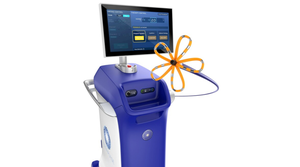May 25, 2011
Strain-gauge sensors are typically used to determine the amount of force required to perform precision assembly and other manufacturing operations. However, in addition to being time-consuming, the use of such dedicated sensors can result in damage to robotic arms if the sensors are unable to prevent a collision between the workpiece and the tool. To prevent such problems, Keba Corp. has designed what it claims is the first product for use in medical device assembly routines that enables automatic, touch-sensitive surface processing independent of the robot or end-of-arm tooling device.
|
Keba's Active Contact flange enables automatic, touch-sensitive surface processing independent of the robot or end-of-arm tooling device. |
"Traditional technologies involve force-sensor feedback that is processed by the robot controller and fed through kinematic equations to redirect the arm to a new position," says Doug Dalgliesh, president of FlexControl Solutions LLC, the master distributor of Keba products. "All of this takes valuable time."
In contrast, Keba's Active Contact flange automatically and independently compensates for positioning to maintain a definable preset force on work surfaces. It processes this feedback and directly controls the flange's pneumatic positioning capability, bypassing the robot controller. The resulting rapid reaction time serves two purposes, according to Dalgliesh. In medical device polishing operations, for example, it ensures quick positioning to maintain the desired force on the work surface; and in assembly operations, it saves milliseconds of time per part, increasing throughputs over millions of lots.
The flange can be used to simplify and improve a host of processes, Dalgliesh states, including surface-treatment procedures and force-sensitive assembly operations. Because it automatically compensates for position and force control, the flange's touch-sensitive technology is suitable for automating various manufacturing processes, including sanding, polishing, buffing, stripping, cleaning, and deburring. It can also perform such force-sensitive operations as gluing, bonding, testing, and delicate positioning.
Among the flange's benefits is automatic collision protection. "Because of its pneumatic positioning design, the flange gives way when a sudden unexpected force is applied against it, such as during a crash of the arm or the introduction of an unexpected barrier on the surface of the workpiece," Dalgliesh notes. "This response maintains the initial desired force and prevents damage to end-of-arm tooling devices such as deburring tools, polishing wheels, or grippers."
Featuring industry-standard mounting patterns and standard interfaces such as Ethernet and other bus options, the flange can be easily integrated into existing manufacturing equipment, including robots. It can perform a variety of medical device manufacturing processes, including the deburring of plastic or metal components and the polishing of orthopedic implants.
FlexControl Solutions LLC
Newtown Square, PA
www.flexcontrolsolutions.com
Keba Corp.
Troy, MI
www.keba.com
You May Also Like

